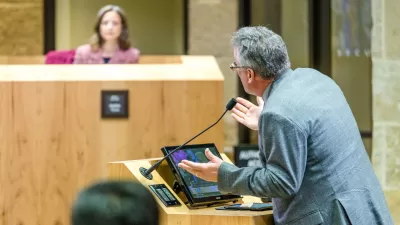A new book explains why people object to new housing in their neighborhoods, and whether these "neighborhood defenders" are representative of the public as a whole.

Not long ago, I read an interesting new book on zoning policy: Neighborhood Defenders, by three political scientists at Boston University. As the title indicates, the book focuses on people who try to limit new development in their neighborhood; although I and many others have often used the term “NIMBY” (Not In My Back Yard) to describe them, the authors suggest that the term “neighborhood defenders” more accurately describes what opponents of housing think they are doing—defending their neighborhood from unwelcome development.
These neighborhood defenders are able to exclude housing because of the public process surrounding zoning. Because zoning laws are so complicated, new building often requires a zoning change, which under current law nearly always requires a public hearing. Neighborhood defenders flock to these hearings and fight the project. Even if a city council is pro-housing, lawsuits or the threat of lawsuits can slow development down. For example, the authors show that a high number of zoning-related lawsuits correlates with a lower share of permits in multifamily buildings.
Based on a survey of dozens of towns in metropolitan Boston, the authors show that the number of zoning regulations is correlated with low levels of housing production, especially low levels of multifamily housing production. Suburbs with many different types of regulation have fewer new apartments or condos, and the buildings that are developed in these suburbs have fewer units. This correlation is not limited to regulations directly limited to housing supply (such as density limits); even more seemingly innocuous regulations can be used to delay housing. In other words, more regulation means less new housing.
Conventional economic wisdom suggests that neighborhood defenders are motivated primarily by a desire to protect their property values by limiting new housing. On the other hand, some new urbanists would like to believe that prettier projects would be more popular. The authors went through meeting minutes in Massachusetts towns, and discovered that neighborhood defenders are more likely to raise concerns about traffic and environmental concerns than either aesthetic or economic concerns. Less than 10 percent of commenters in the authors' sample directly mentioned aesthetic concerns, and even fewer mentioned home values. This may mean that neighborhood defenders really believe that new development is bad because it brings traffic and environmental degradation—or that they are sophisticated enough to know that complaining about ugly apartments or property values might not be as persuasive as traffic-related and environmental arguments.
The traditional justification for public meetings about zoning is that commenters represent the public. The authors disprove this idea: commenters at zoning meetings are much more likely to be homeowners as opposed to renters, and are whiter, older and more male. In the towns surveyed, 73 percent of commenters were homeowners, as opposed to 46 percent of all voters. Only 5 percent of commenters were nonwhite, as opposed to 13 percent of all voters. Nonwhites were generally more pro-housing than whites; just under 15 percent of white commenters supported new housing, as opposed to 45 percent of blacks. On the other hand, the sample of black commenters was so small (only 60) that I am not sure this fact is statistically significant. Hispanic commenters were even more anti-housing than whites—but here too, the sample size (29 commenters) seems too small to be probative.
The authors suggest that the opinions of neighborhood defenders are not representative of the public as a whole. They rely on the results of a 2010 referendum in Massachusetts on repealing Ch. 40B. Most voters voted no—that is, they supported affordable housing. By contrast, only 15 percent of commenters spoke in support of new housing at zoning hearings. On the other hand, it could be argued that voters were happy to support new housing as long as it was likely to be in someone else’s neighborhood, or that they preferred low-income housing to market-rate housing.
Thus, zoning creates a collective action problem: what might be good for each individual neighborhood (preventing new housing) is bad for the city or region as a whole. To solve this problem, the authors favor citywide and statewide zoning reforms, as well as more federal support for low-income housing.

Maui's Vacation Rental Debate Turns Ugly
Verbal attacks, misinformation campaigns and fistfights plague a high-stakes debate to convert thousands of vacation rentals into long-term housing.

Planetizen Federal Action Tracker
A weekly monitor of how Trump’s orders and actions are impacting planners and planning in America.

San Francisco Suspends Traffic Calming Amidst Record Deaths
Citing “a challenging fiscal landscape,” the city will cease the program on the heels of 42 traffic deaths, including 24 pedestrians.

Defunct Pittsburgh Power Plant to Become Residential Tower
A decommissioned steam heat plant will be redeveloped into almost 100 affordable housing units.

Trump Prompts Restructuring of Transportation Research Board in “Unprecedented Overreach”
The TRB has eliminated more than half of its committees including those focused on climate, equity, and cities.

Amtrak Rolls Out New Orleans to Alabama “Mardi Gras” Train
The new service will operate morning and evening departures between Mobile and New Orleans.
Urban Design for Planners 1: Software Tools
This six-course series explores essential urban design concepts using open source software and equips planners with the tools they need to participate fully in the urban design process.
Planning for Universal Design
Learn the tools for implementing Universal Design in planning regulations.
Heyer Gruel & Associates PA
JM Goldson LLC
Custer County Colorado
City of Camden Redevelopment Agency
City of Astoria
Transportation Research & Education Center (TREC) at Portland State University
Jefferson Parish Government
Camden Redevelopment Agency
City of Claremont






























